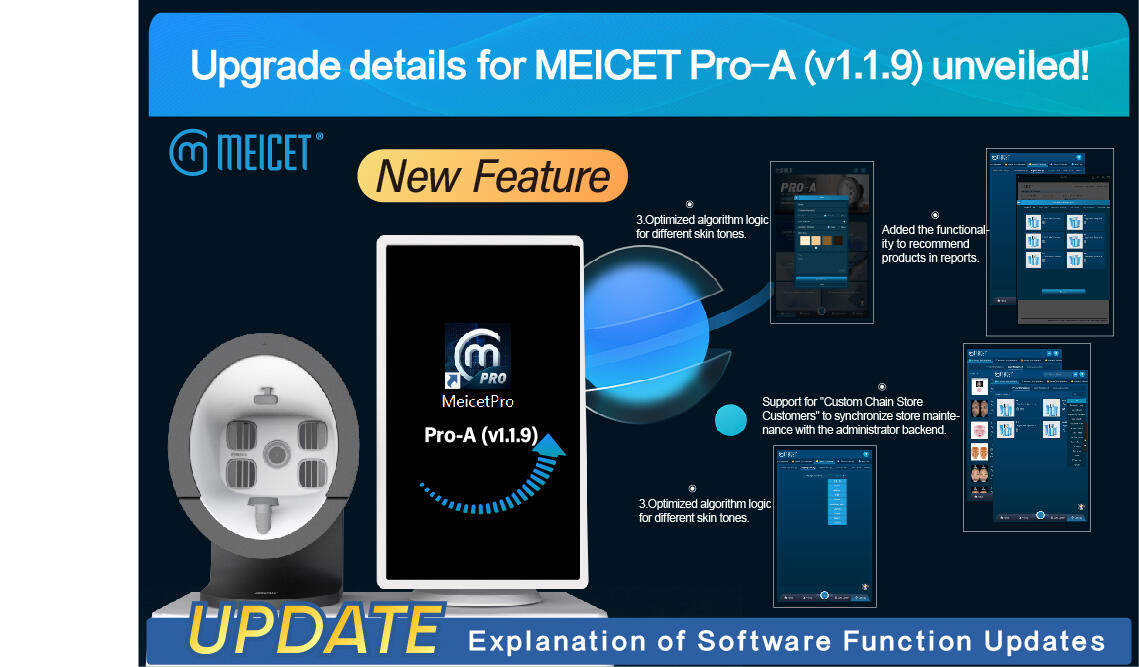
Sensitive skin presents a spectrum of challenges for dermatologists, from distinguishing rosacea from contact dermatitis to identifying underlying inflammation that evades the naked eye. MEICET’s Pro-A Skin Imaging Analyzer, equipped with advanced multi-spectral imaging, has emerged as a critical tool in navigating these complexities. By combining RGB, cross-polarized light (CPL), parallel-polarized light (PPL), and ultraviolet (UV) imaging, it delivers a layered understanding of sensitive skin—uncovering details that transform vague symptoms into actionable diagnoses.
Unpacking Sensitive Skin Dynamics
Sensitive skin is rarely a single issue; it often involves a compromised barrier, vascular irregularities, or subclinical inflammation. The Pro-A’s multi-spectral capabilities dissect these components with precision:
- CPL imaging penetrates surface reflections to highlight capillary dilation, a hallmark of rosacea. What appears as “mild redness” to the eye may reveal a network of enlarged capillaries under CPL, confirming inflammatory activity rather than temporary irritation from factors like weather or skincare products. This distinction is critical: rosacea requires targeted anti-inflammatory treatments, while transient redness may only need gentle soothing care.
- PPL imaging focuses on the epidermis, mapping barrier integrity by detecting changes in light scattering. This is invaluable for assessing atopic dermatitis, where a weakened barrier appears as irregular texture or uneven light absorption. Clinicians can use these patterns to differentiate between barrier damage from genetics versus external irritants, guiding whether to recommend lipid-rich moisturizers or allergen avoidance.
- UV imaging exposes porphyrins—byproducts of bacteria linked to acne-related sensitivity—helping clinicians connect breakouts to microbial activity that might exacerbate redness. For example, a patient with “persistent red bumps” may show high porphyrin levels under UV, indicating that antibacterial treatments are needed to address the root cause.
Consider a patient presenting with “persistent facial redness” that worsens with heat. Pro-A scans might reveal: CPL highlighting widespread capillary dilation (consistent with rosacea), PPL showing intact but thin barrier function (ruling out atopic dermatitis), and UV with minimal porphyrin activity (eliminating acne as a driver). This combination guides a targeted plan: topical azelaic acid to calm vasculature, gentle cleansers to support the barrier, and no antibiotic intervention—avoiding unnecessary treatments that could disrupt skin balance.
Guiding Treatment with Objective Metrics
Traditional assessments of sensitive skin rely heavily on patient reports of “burning” or “tightness”—subjective measures that vary widely based on individual tolerance and perception. The Pro-A introduces objective metrics that ground treatment decisions in data:
- Redness quantification via CPL heatmaps tracks changes in vascular activity over time. A patient using a new soothing serum can have their progress measured by reduced red pixel density in targeted areas, validating whether the product is truly calming inflammation or just masking symptoms. This data helps clinicians discontinue ineffective treatments early, saving time and reducing patient frustration.
- Barrier function scores from PPL imaging quantify how well the stratum corneum retains moisture by analyzing light reflection patterns. For patients with atopic dermatitis, consistently low scores indicate that the current moisturizer is insufficient, prompting a switch to formulations with higher ceramide or cholesterol content. Conversely, improving scores confirm that the barrier is healing, allowing for gradual reintroduction of actives like mild exfoliants.
- Inflammation markers detected via near-infrared imaging (a component of the Pro-A’s multi-spectral suite) distinguish between transient irritation and chronic inflammation. This is particularly useful post-procedurally: after a laser treatment, mild, localized inflammation is normal, but widespread, persistent signals may indicate over-treatment, requiring adjusted cooling protocols or anti-inflammatory topicals.
In clinical settings, this data transforms sensitive skin management from trial-and-error to precision care. A dermatologist treating a patient with post-procedural redness can use CPL scans to determine if the inflammation is localized to the treated site (requiring targeted soothing) or systemic (needing broader anti-inflammatory support), ensuring interventions are both effective and minimally invasive.
Enhancing Long-Term Monitoring
Sensitive skin conditions often fluctuate with seasons, stress, or product use, making long-term tracking essential. The Pro-A’s before-and-after comparison tools enable consistent monitoring that captures these nuances:
- A patient with seasonal sensitivity can have baseline scans in winter (showing heightened barrier permeability from cold, dry air) and summer (revealing UV-induced inflammation from increased sun exposure). These scans guide seasonal adjustments: richer moisturizers in winter, antioxidant serums and stricter sun protection in summer.
- For those undergoing laser treatments for pigmentation (a common concern in sensitive skin), PPL imaging monitors barrier recovery post-procedure. If scans show persistent barrier weakness six weeks after treatment, clinicians can delay subsequent sessions or switch to lower-intensity settings, preventing cumulative damage.
- Patients with rosacea can benefit from quarterly scans to track how vascular activity responds to lifestyle changes (e.g., stress reduction, alcohol avoidance). Consistently reduced redness in CPL mode confirms that behavioral modifications are working, reinforcing patient adherence to these habits.
By merging multi-spectral data with clinical expertise, the Pro-A empowers dermatologists to move beyond managing symptoms—addressing the root causes of sensitive skin with clarity and confidence. It transforms vague complaints into measurable, treatable conditions, ensuring that every intervention is tailored to the skin’s unique needs.
 EN
EN
 AR
AR
 BG
BG
 HR
HR
 CS
CS
 DA
DA
 NL
NL
 FI
FI
 FR
FR
 DE
DE
 EL
EL
 HI
HI
 IT
IT
 JA
JA
 KO
KO
 NO
NO
 PL
PL
 PT
PT
 RO
RO
 RU
RU
 ES
ES
 SV
SV
 TL
TL
 IW
IW
 ID
ID
 SR
SR
 SK
SK
 SL
SL
 UK
UK
 VI
VI
 SQ
SQ
 HU
HU
 TH
TH
 TR
TR
 FA
FA
 AF
AF
 MS
MS
 UR
UR
 BN
BN
 LA
LA

